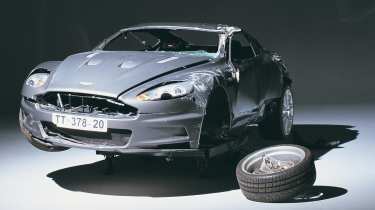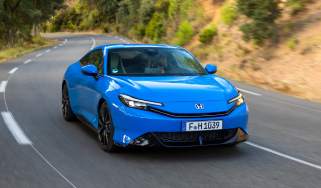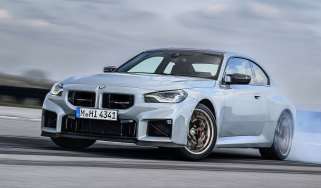Aston Martin DBS: How James Bond crashed his Aston
What happened when Aston Martin lent its brand new DBS to the world’s best known secret agent
The choice of star car for Casino Royale was made in late 2005 when then Aston boss Dr Ulrich Bez invited Bond producer Barbara Broccoli up to Gaydon to look at a new DB9-based model under development in the design studio. Broccoli loved the car and immediately cast it as the perfect transport for Daniel Craig’s leaner, meaner, slightly blonder Bond.
This left Aston with a small problem. The new car, to be called DBS, wasn’t due to be launched until 2007 and at that point it was just a styling buck still being finessed by design director Marek Reichman. No actual DBSs existed and it wasn’t going to be much of a starring role if all Bond did was lean casually on a clay model.
> Click here for more on the all-new Aston Martin Vantage
With principle photography due to start in January 2006, Aston’s prototype workshop pulled out all the extruded aluminium stops to hand-build two identical DBS ‘hero’ cars that could be used for close-up shots and gentle driving. Externally these cars looked near-as-dammit like the proposed production DBS. Inside, the Aston design team were given a little more licence, installing a crash helmet cubby, gun holder, and other cheeky features unlikely to be seen on customers’ cars unless they ask really nicely. The build team worked flat out and the cars were delivered to the Bond crew as promised in April 2006.
But Aston’s commitments didn’t end there. In the script, 007 discovers his love interest Vesper Lynd has been kidnapped and hammers his Aston along the twisting roads of Montenegro in hot pursuit. Director Martin Campbell wanted the audience to think they were about to see a lengthy car chase and then surprise them when instead Bond encounters Lynd lying on the road ahead, swerves to avoid her and flips his car into a spectacular barrel-roll. Ripping stuff on screen, but a headache for the Gaydon workshop, which had to fulfil the film makers’ request for three cosmetically accurate DBS stunt cars.
> Click here for our review of the late Aston Martin DB9 GT
Fortunately Aston had a trio of redundant DB9 development hacks and drafted them into the prototype shop to be turned into DBS replicas. From the outside these sacrificial lambs looked identical to the fully formed ‘hero’ cars already working their stuff for the cameras. Inside, they were rather less polished, with tatty, rough-grained dashboards and stout roll-cages betraying their origins as pre-production workhorses. The tired matt-black vents and buttons on the top half of the dash were pretty far from the chrome-splashed versions in the show cars but, to avoid any risk of knackering continuity, the team came up with a cunning fix involving careful application of kitchen tin-foil.
Once again Aston met its deadline, delivering the three action cars to the Bond vehicle team along with the original DB9 manual gearbox prototype, looking scruffy and care-worn in its flaking white paintjob, so that the stunt drivers had a fourth car in which to practise.
> Click here for our review of the Aston Martin DBS
Final planning for the stunt took place at Dunsfold Aerodrome near Guildford, familiar to TV viewers as home to the Top Gear test track, where the Casino Royale second unit was busy filming an explosive night-time sequence with kerosene tankers and an old 747. In the final movie you’d never guess that the fiery chase around Miami International Airport was actually shot in rural Surrey, especially once a twinkling Floridian city- scape had been digitally added to the background during post-production.
On another part of the airfield the stunt team set up the eight-inch ramp they calculated would be enough to flip the DBS and brought in two battered E34 BMW 5-series, chosen because they broadly replicated the size and weight of the Aston, for a couple of rehearsal rolls. Stunt co-ordinator Gary Powell had found a couple of dramatic rallycross crashes on the internet and was aiming for a similar multi-roll spectacular with the Aston. Sure enough, when they hit the ramp at 65mph, the Bee-Ems barrelled three or four times, in exactly the way Powell was looking for.
Satisfied that the stunt would work, the Bond crew moved to the hill circuit at Millbrook proving ground in Bedfordshire, doubling for the country roads of Montenegro, and carried out some final trials with their DB9 practice car. Unfortunately, the Aston proved a lot more stable than those crusty 5-series and, with only limited chances to get this right, the ramp was raised to 18 inches to make sure the Bond car turned turtle.
> Click here for our list of the best GT cars in 2018
As it turned out, this still wasn’t enough. When stunt driver Adam Kirley charged the first DBS into the ramp at 70mph it simply took off, levelled out and landed on all four wheels, clouting the dummy that stood in for the prone Vesper Lynd before mangling its front suspension as it slithered unimpressively across the damp grass. The Aston’s stiffer chassis and lower centre of gravity meant it wasn’t inclined to go belly-up like those BMWs at Dunsfold.
Fortunately, the Bond team had a back-up plan involving another DBS fitted with a gas cannon that used pressurised nitrogen to punch a metal ram out of the bottom of the car and flip it onto its roof. It was up to Adam Kirley to hit the trigger at precisely the right moment, otherwise he’d risk being punted painfully into the trees by the side of the road.
With everything in place and the cameras running, Kirley gunned the Aston up to 75mph, came charging onto the wet tarmac of the beautifully lit filming area, swerved slightly to the left and fired the ram bang on cue. The result was even more spectacular than the stunt team had imagined. Once the Aston hit the grass, it dug in and just kept rolling, pieces of bodywork and a wheel flying off until it came to rest, right side up, lights still twinkling into the Millbrook undergrowth.
> Click here for our look ahead at 2018's most exciting new cars
Kirley later described being in the car as ‘a fairly violent sort of ride’ but incredibly he stepped from the mashed Aston unhurt. He didn’t know at the time that he’d just established a new Guinness World Record for most cannon rolls in a car, achieving an astonishing seven complete turns and stealing the record from Top Gear, who had previously set the benchmark using a rather less glamorous Sierra estate.
If the ramp had been used it would have been hidden under a pile of peat to make it look like the car had flipped off the grass verge. Since they’d successfully deployed the cannon instead, a new bridging shot was required to establish the start of the roll and two weeks later the team returned to Millbrook with the third DBS action car, packed on one side with counterweights.
When Adam Kirley swerved around a flinching Vesper Lynd – actually stunt performer Nikki Berwick doubling for actress Eva Green – these weights were enough to pitch it onto its roof to make the first shot of the crash sequence that you see in the movie. With this extra roll in the bag, that was it. Three real Aston Martins successfully and spectacularly trashed.
When filming wrapped, the wrecked DBS replicas were returned to Gaydon where, in line with standard practice for development cars, they were due to be crushed, allowing the company to reclaim the VAT on their value and avoiding the risk of rogue prototype parts getting into the public domain. But from the mangled beauty you see here, you’ll notice the cannon-roll car has so far escaped the breakers’ yard. After its moment of record-breaking movie stardom, the chaps at Aston admit they’ve become quite attached to it.
DBS On The Way
Bond may already have driven – and destroyed – his new Aston DBS, but the rest of us will have to wait a little longer. The best estimate for its official arrival is October 2007, almost 12 months after its big screen debut. Precise details of the production spec are still sketchy, but a few choice bits of info have leaked out of Gaydon.
For a start the car is going to be around 100kg lighter than a conventional DB9 (putting its kerb weight at around 1660kg) thanks to extensive use of carbon composite panels (including the vented bonnet and front wings), reduced sound- deadening material and the deletion of the rear seats within the otherwise relatively standard cabin.
The 6-litre V12 engine has been tweaked to deliver another 50bhp over the standard DB9, breaking through the 500bhp barrier that up until now has been the preserve of the Vanquish. That’s no accident, because the Vanquish is due to cease production later this year, effectively making the DBS Aston Martin’s new flagship when it goes on sale.
Aston wants the DBS to be seen as a serious drivers’ car, which is why it’ll come only with a manual gearbox and feature ceramic brakes as standard. Along with the lighter stoppers, the wheels are special lightweight forgings that’ll help reduce the unsprung weight still further. Performance-wise, expect a 0-60 of around four seconds and a top speed that could make the DBS a true 200mph Aston.
Another first for the company is the introduction of a keyless-go system, finally banishing A-M’s usual cheapo Ford-sourced ignition key. Instead, the DBS uses a lump of crystal and aluminium that slots into a hole where the DB9’s starter button usually lives.
The new car will need special details like this to help justify its high price compared with a standard DB9 Sports Pack. It’s expected to cost in excess of £160,000 and very possibly as high as £180,000 if you let fly with the options. God knows how much an onboard defibrillator would cost… Given what happened to Bond’s DBS in Casino Royale, he should count himself lucky he didn’t have to pay for it.
Harry Metcalfe




